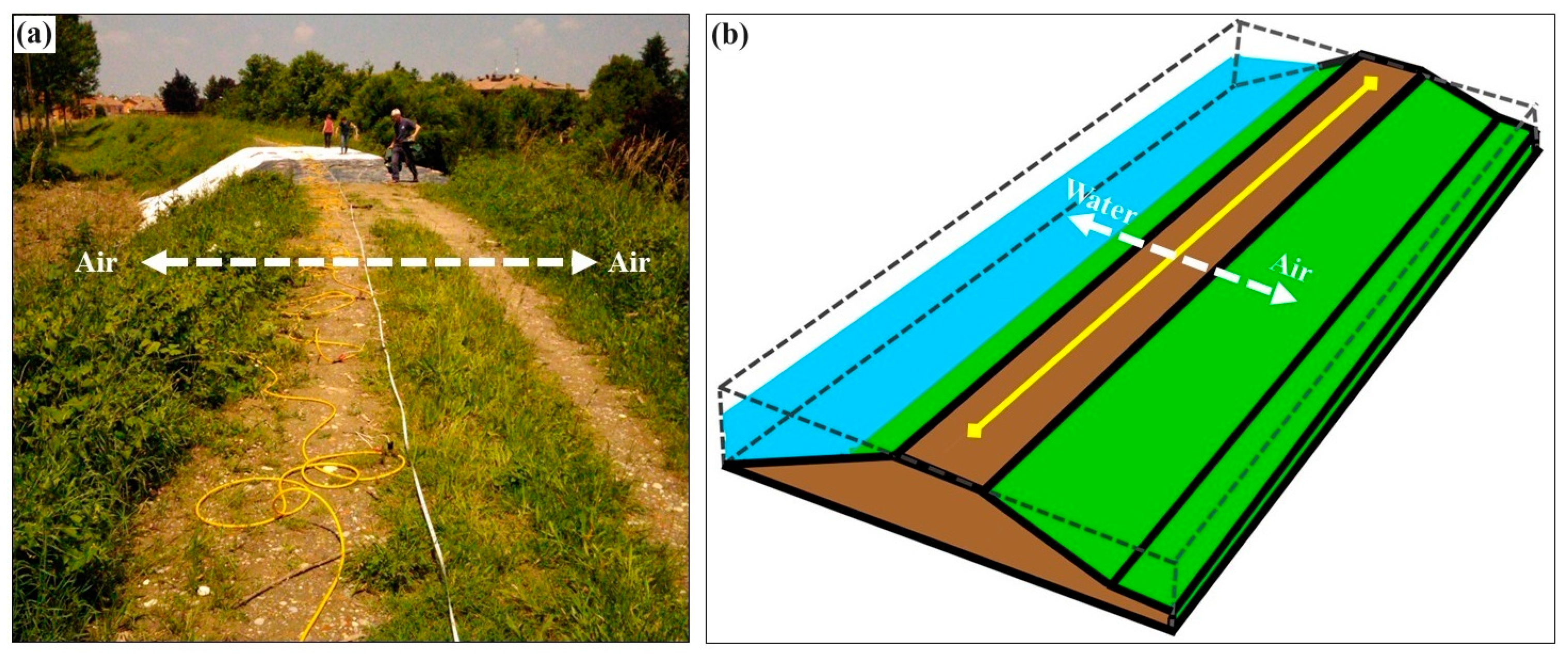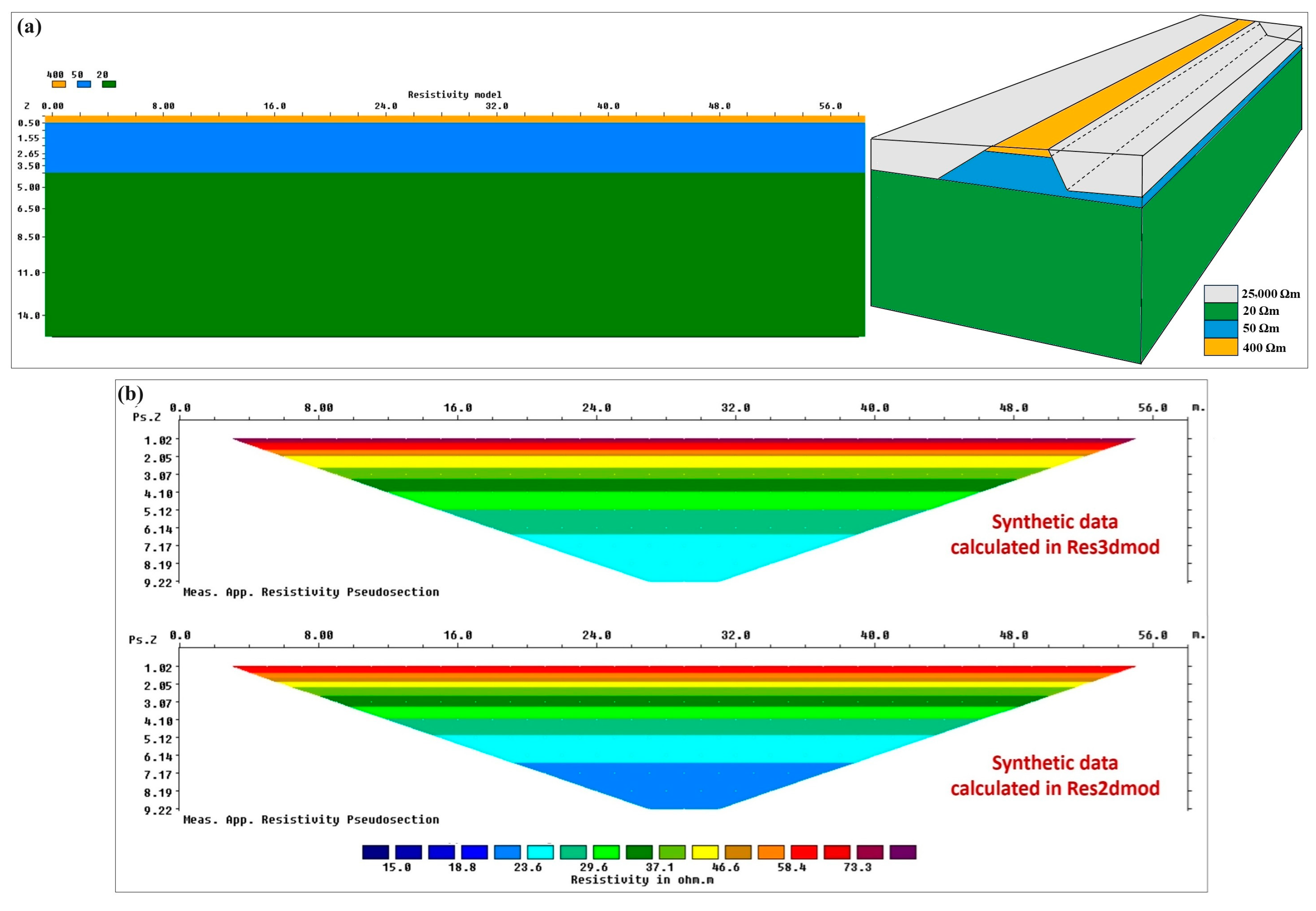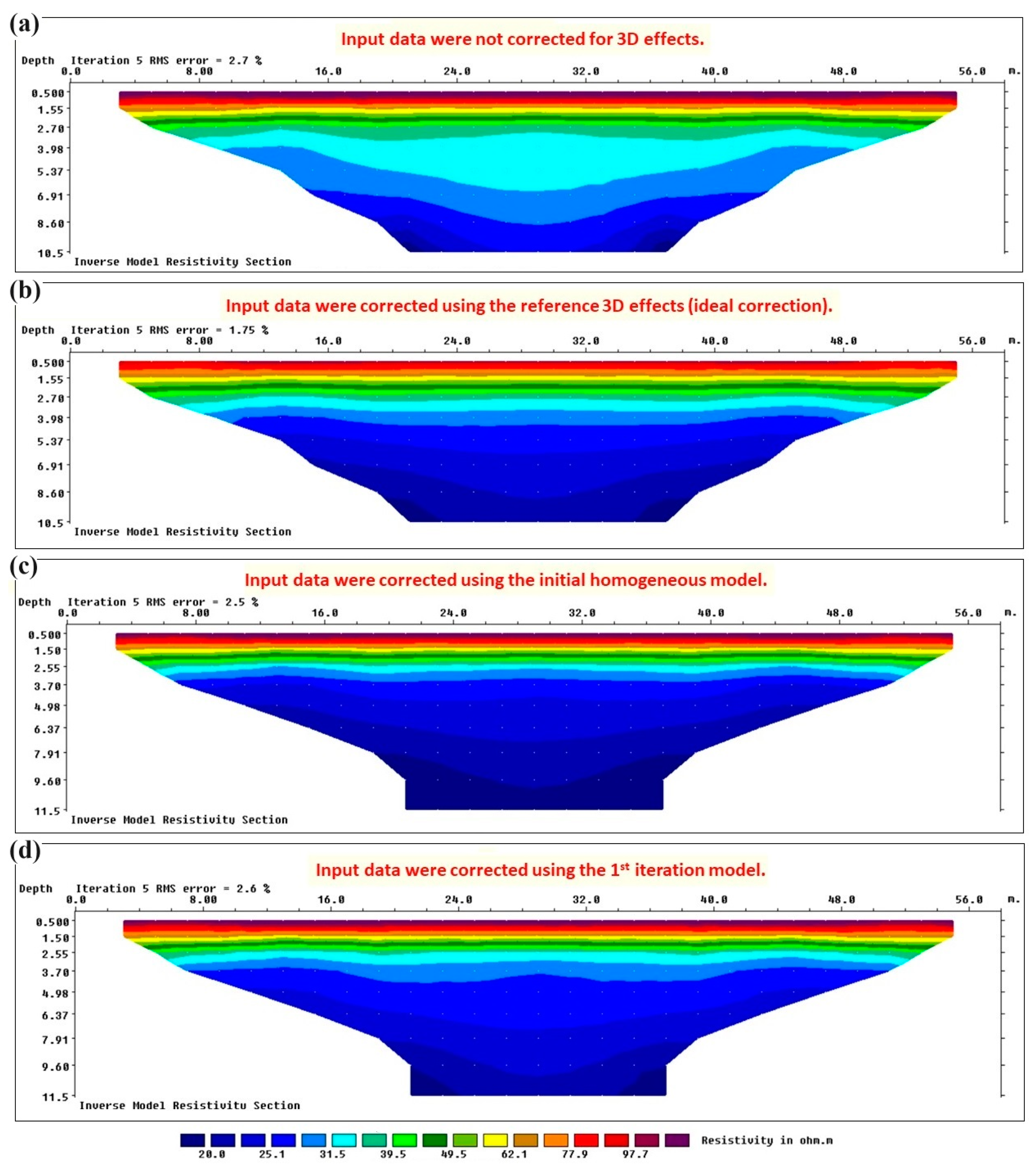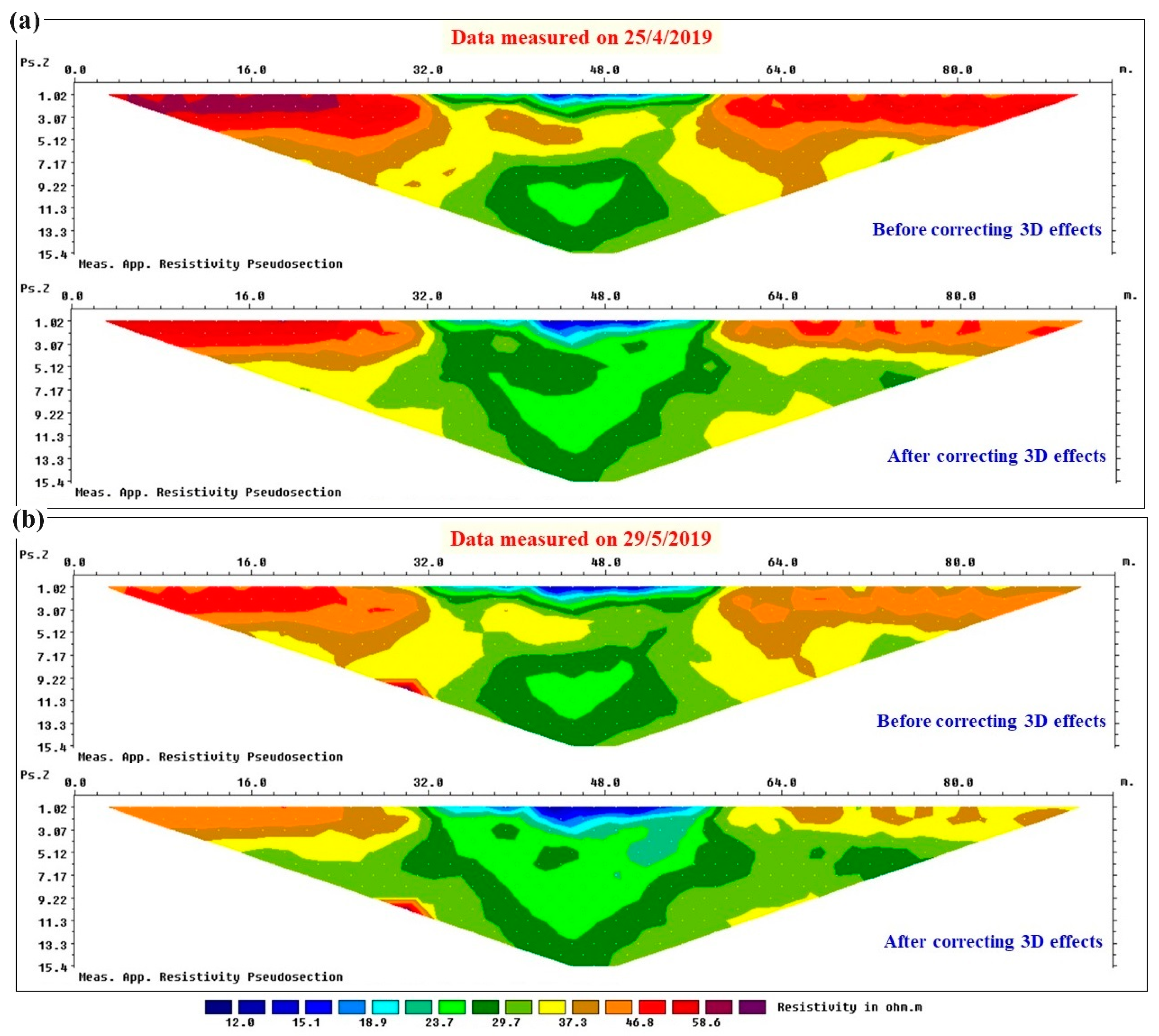An Iterative 3D Correction plus 2D Inversion Procedure to Remove 3D Effects from 2D ERT Data along Embankments
Abstract
1. Introduction
2. The Study Site
3. Correcting 3D Effects
3.1. Synthetic Models
- Synthetic test no. 1 presents one of the most common situations for a more-or-less homogeneous embankment resting on a conductive clayey subsoil. This model also considers a superficial resistive layer that covers river levees (like a gravel road for cyclists and runners).
- Synthetic test no. 2, on the other hand, presents simulations inspired by the special composition of the study site where there is a central inhomogeneous zone due to a repair operation.
3.1.1. Synthetic Test No. 1
3.1.2. Synthetic Test No. 2
3.2. Field Data
4. Discussion
5. Conclusions
Funding
Institutional Review Board Statement
Informed Consent Statement
Data Availability Statement
Acknowledgments
Conflicts of Interest
References
- Hojat, A.; Ferrario, M.; Arosio, D.; Brunero, M.; Ivanov, V.I.; Longoni, L.; Madaschi, A.; Papini, M.; Tresoldi, G.; Zanzi, L. Laboratory studies using electrical resistivity tomography and fiber optic techniques to detect seepage zones in river embankments. Geosciences 2021, 11, 69. [Google Scholar] [CrossRef]
- Hu, Z.; Shan, W. Landslide investigations in the northwest section of the lesser Khingan range in China using combined HDR and GPR methods. B Eng. Geol. Environ. 2016, 75, 591–603. [Google Scholar] [CrossRef]
- Amitrano, D.; Arattano, M.; Chiarle, M.; Mortara, G.; Occhiena, C.; Pirulli, M.; Scavia, C. Microseismic activity analysis for the study of the rupture mechanisms in unstable rock masses. Nat. Hazard. Earth Syst. 2010, 10, 831–841. [Google Scholar] [CrossRef]
- Arosio, D.; Longoni, L.; Papini, M.; Boccolari, M.; Zanzi, L. Analysis of microseismic signals collected on an unstable rock face in the Italian Prealps. Geophys. J. Int. 2018, 213, 475–488. [Google Scholar] [CrossRef]
- Lundberg, E.; Malehmir, A.; Juhlin, C.; Bastani, M.; Andersson, M. High-resolution 3D reflection seismic investigation over a quick-clay landslide scar in southwest Sweden. Geophysics 2014, 79, B97–B107. [Google Scholar] [CrossRef]
- Zhang, Z.; Arosio, D.; Hojat, A.; Zanzi, L. Tomographic experiments for defining the 3D velocity model of an unstable rock slope to support microseismic event interpretation. Geosciences 2020, 10, 327. [Google Scholar] [CrossRef]
- Dahlin, T.; Leroux, V.; Larsson, R.; Rankka, K. Resistivity imaging for mapping of quick clays for landslide risk assessment. In Proceedings of the 11th European Meeting of Environmental and Engineering Geophysics, Palermo, Italy, 4–7 September 2005. [Google Scholar] [CrossRef]
- Piegari, E.; Cataudella, V.; Di Maio, R.; Milano, L.; Nicodemi, M.; Soldovieri, M.G. Electrical resistivity tomography and statistical analysis in landslide modelling: A conceptual approach. J. Appl. Geophys. 2008, 68, 151–158. [Google Scholar] [CrossRef]
- Chambers, J.E.; Meldrum, P.I.; Gunn, D.A.; Wilkinson, P.B.; Kuras, O.; Weller, A.L.; Ogilvy, R.D. Hydrogeophysical monitoring of landslide processes using automated time-lapse electrical resistivity tomography (ALERT). In Proceedings of the 15th European Meeting of Environmental and Engineering Geophysics, Dublin, Ireland, 7–9 September 2009. [Google Scholar] [CrossRef][Green Version]
- Chambers, J.E.; Holmes, J.; Whiteley, J.; Boyd, J.; Meldrum, P.I.; Wilkinson, P.B.; Kuras, O.; Swift, R.; Harrison, H.; Glendinning, S.; et al. Long-term geoelectrical monitoring of landslides in natural and engineered slopes. Lead. Edge 2022, 41, 742–804. [Google Scholar] [CrossRef]
- Hojat, A.; Arosio, D.; Di Luch, I.; Ferrario, M.; Ivanov, V.I.; Longoni, L.; Madaschi, A.; Papini, M.; Tresoldi, G.; Zanzi, L. Testing ERT and fiber optic techniques at the laboratory scale to monitor river levees. In Proceedings of the 25th European Meeting of Environmental and Engineering Geophysics, The Hague, The Netherlands, 8–12 September 2019. [Google Scholar] [CrossRef]
- Chambers, J.E.; Gunn, D.A.; Wilkinson, P.B.; Meldrum, P.I.; Haslam, E.; Holyoake, S.; Kirkham, M.; Kuras, O.; Merritt, A.; Wragg, J. 4D Electrical Resistivity Tomography monitoring of soil moisture dynamics in an operational railway embankment. Near Surf. Geophys. 2014, 12, 61–72. [Google Scholar] [CrossRef]
- Tresoldi, G.; Hojat, A.; Zanzi, L. G.RE.T.A. installations for real-time monitoring of irrigation dams and canals. Procedia Environ. Sci. Eng. Manag. 2020, 7, 271–276. [Google Scholar]
- Chambers, J.E.; Kuras, O.; Meldrum, P.I.; Ogilvy, R.D.; Hollands, J. Electrical resistivity tomography applied to geologic, hydrogeologic, and engineering investigations at a former waste-disposal site. Geophysics 2006, 71, B231–B239. [Google Scholar] [CrossRef]
- Keller, G.V.; Frischknecht, F.C. Electrical Methods in Geophysical Prospecting; Pergamon Press: Oxford, UK, 1966. [Google Scholar]
- Loke, M.H.; Chambers, J.E.; Rucker, D.F.; Kuras, O.; Wilkinson, P.B. Recent developments in the direct-current geoelectrical imaging method. J. Appl. Geophys. 2013, 95, 135–156. [Google Scholar] [CrossRef]
- Ungureanu, C.; Priceputu, A.; Bugea, A.L.; Chirică, A. Use of electric resistivity tomography (ERT) for detecting underground voids on highly anthropized urban construction sites. Procedia Eng. 2017, 209, 202–209. [Google Scholar] [CrossRef]
- Martel, R.; Castellazzi, P.; Gloaguen, E.; Trépanier, L.; Garfias, J. ERT, GPR, InSAR, and tracer tests to characterize karst aquifer systems under urban areas: The case of Quebec City. Geomorphology 2018, 310, 45–56. [Google Scholar] [CrossRef]
- Hojat, A.; Zanzi, L.; Ranjbar, H.; Karimi Nasab, S.; Loke, M.H. An opportunity to directly observe qanat galleries at depth and test electrical resistivity tomography surveys. In Proceedings of the 5th Asia Pacific Meeting on Near Surface Geoscience & Engineering, Taipei, Taiwan, 6–9 March 2023. [Google Scholar] [CrossRef]
- Strzałkowski, P.; Ścigała, R.; Szafulera, K.; Kołodziej, K. Surface deformations resulting from abandoned mining excavations. Energies 2021, 14, 2495. [Google Scholar] [CrossRef]
- Batista-Rodríguez, J.A.; Pérez-Flores, M.A. Contribution of ERT on the study of Ag-Pb-Zn, Fluorite, and Barite deposits in northeast Mexico. Minerals 2021, 11, 249. [Google Scholar] [CrossRef]
- Junaid, M.; Abdullah, R.A.; Sa’ari, R.; Ali, W.; Hafeez, R.; Alel, M.N.A.; Usman, G. 2D Electrical Resistivity Tomography an advance and expeditious exploration technique for current challenges to mineral industry. J. Himal. Earth Sci. 2021, 54, 11–32. [Google Scholar]
- Aguzzoli, A.; Hojat, A.; Zanzi, L.; Arosio, D. Two dimensional ERT simulations to check the integrity of geomembranes at the base of landfill bodies. In Proceedings of the 26th European Meeting of Environmental and Engineering Geophysics, Amsterdam, The Netherlands, Online, 7–8 December 2020; ISBN 978-946282355-6. [Google Scholar] [CrossRef]
- Mutafela, R.N.; Lopez, E.G.; Dahlin, T.; Kaczala, F.; Marques, M.; Jani, Y.; Hogland, W. Geophysical investigation of glass ‘hotspots’ in glass dumps as potential secondary raw material sources. Waste Manag. 2020, 106, 213–225. [Google Scholar] [CrossRef] [PubMed]
- Moradipour, M.; Ranjbar, H.; Hojat, A.; Karimi Nasab, S.; Daneshpajouh, S. Laboratory and field measurements of electrical resistivity to study heap leaching pad no. 3 at Sarcheshmeh copper mine. In Proceedings of the 22nd European Meeting of Environmental and Engineering Geophysics, Barcelona, Spain, 4–8 September 2016. [Google Scholar] [CrossRef]
- Rucker, D.F.; Schindler, A.; Levitt, M.T.; Glaser, D.R. Three-dimensional electrical resistivity imaging of a gold heap. Hydrometallurgy 2009, 98, 267–275. [Google Scholar] [CrossRef]
- Gabarrón, M.; Martínez-Pagán, P.; Martínez-Segura, M.A.; Bueso, M.C.; Martínez-Martínez, S.; Faz, Á.; Acosta, J.A. Electrical Resistivity Tomography as a support tool for physicochemical properties assessment of near-surface waste materials in a mining tailing pond (El Gorguel, SE Spain). Minerals 2020, 10, 559. [Google Scholar] [CrossRef]
- Pearson, A.J.; Rucker, D.F.; Tsai, C.; Fuchs, E.H.; Carroll, K.C. Electrical resistivity monitoring of lower Rio Grande River-Groundwater intermittency. J. Hydrol. 2022, 613, 128325. [Google Scholar] [CrossRef]
- Hussein, M.A.; Ali, M.Y.; Hussein, H.A. Groundwater investigation through Electrical Resistivity Tomography in the Galhareri district, Galgaduud region, Somalia: Insights into hydrogeological properties. Water 2023, 15, 3317. [Google Scholar] [CrossRef]
- Watlet, A.; Thirugnanam, H.; Singh, B.; Kumar, N.; Brahmanandan, D.; Inauen, C.; Swift, R.; Meldrum, P.; Uhlemann, S.; Wilkinson, P.; et al. 4D electrical resistivity to monitor unstable slopes in mountainous tropical regions: An example from Munnar, India. Landslides 2023, 20, 1031–1044. [Google Scholar] [CrossRef]
- Kuras, O.; Pritchard, J.D.; Meldrum, P.I.; Chambers, J.E.; Wilkinson, P.; Ogilvy, R.D.; Wealthall, G.P. Monitoring hydraulic processes with automated time-lapse electrical resistivity tomography (ALERT). Comptes Rendus Geosci. 2009, 341, 868–885. [Google Scholar] [CrossRef]
- Sjödahl, P.; Dahlin, T.; Johansson, S. Embankment dam seepage evaluation from resistivity monitoring data. Near Surf. Geophys. 2009, 7, 463–474. [Google Scholar] [CrossRef]
- Aleardi, M.; Vinciguerra, A.; Stucchi, E.; Hojat, A. Probabilistic inversions of electrical resistivity tomography data with a machine learning-based forward operator. Geophys. Prospect. 2022, 70, 938–957. [Google Scholar] [CrossRef]
- Perrone, A.; Lapenna, V.; Piscitelli, S. Electrical resistivity tomography technique for landslide investigation: A review. Earth-Sci. Rev. 2014, 135, 65–82. [Google Scholar] [CrossRef]
- Crawford, M.M.; Bryson, L.S.; Woolery, E.W.; Wang, Z. Using 2-D electrical resistivity imaging for joint geophysical and geotechnical characterization of shallow landslides. J. Appl. Geophys. 2018, 157, 37–46. [Google Scholar] [CrossRef]
- Brunet, P.; Clément, R.; Bouvier, C. Monitoring soil water content and deficit using Electrical Resistivity Tomography (ERT)—A case study in the Cevennes area, France. J. Hydrol. 2010, 380, 146–153. [Google Scholar] [CrossRef]
- Hilbich, C.; Fuss, C.; Hauck, C. Automated time-lapse ERT for improved process analysis and monitoring of frozen ground. Permafr. Periglac. Process 2011, 24, 306–319. [Google Scholar] [CrossRef]
- Supper, R.; Ottowitz, D.; Jochum, B.; Kim, J.H.; Romer, A.; Baron, I.; Pfeiler, S.; Lovisolo, M.; Gruber, S.; Vecchiotti, F. Geoelectrical monitoring: An innovative method to supplement landslide surveillance and early warning. Near Surf. Geophys. 2014, 12, 133–150. [Google Scholar] [CrossRef]
- Dahlin, T. Geoelectrical monitoring of embankment dams for detection of anomalous seepage and internal erosion—Experiences and work in progress in Sweden. In Proceedings of the Fifth International Conference on Engineering Geophysics (ICEG), Al Ain, United Arab Emirates, 21–24 October 2019. [Google Scholar] [CrossRef]
- Crawford, M.M.; Bryson, L.S.; Woolery, E.W.; Wang, Z. Long-term landslide monitoring using soil-water relationships and electrical data to estimate suction stress. Eng. Geol. 2019, 251, 146–157. [Google Scholar] [CrossRef]
- Gance, J.; Malet, J.P.; Supper, R.; Sailhac, P.; Ottowitz, D.; Jochumb, B. Permanent electrical resistivity measurements for monitoring water circulation in clayey landslides. J. Appl. Geophys. 2016, 126, 98–115. [Google Scholar] [CrossRef]
- Bièvre, G.; Oxarango, L.; Günther, T.; Goutaland, D.; Massardi, M. Improvement of 2D ERT measurements conducted along a small earth-filled dyke using 3D topographic data and 3D computation of geometric factors. J. Appl. Geophys. 2018, 153, 100–112. [Google Scholar] [CrossRef]
- Zanzi, L.; Hojat, A. Iterative inversion of 2D electrical resistivity tomography data to remove 3D effects. In Proceedings of the 5th International Conference on Advances in Signal Processing and Artificial Intelligence (ASPAI), Tenerife, Spain, 7–9 June 2023; pp. 159–163. [Google Scholar]
- Sjödahl, P.; Dahlin, T.; Zhou, B. 2.5D resistivity modeling of embankment dams to assess influence from geometry and material properties. Geophysics 2006, 71, G107–G114. [Google Scholar] [CrossRef]
- Norooz, R.; Olsson, P.; Dahlin, T.; Günther, T.; Bernstone, C. A geoelectrical pre-study of Älvkarleby test embankment dam: 3D forward modelling and effects of structural constraints on the 3D inversion model of zoned embankment dams. J. Appl. Geophys. 2021, 191, 104355. [Google Scholar] [CrossRef]
- Ball, J.; Chambers, J.; Wilkinson, P.; Binley, A. Resistivity imaging of river embankments: 3D effects due to varying water levels in tidal rivers. Near Surf. Geophys. 2023, 21, 93–110. [Google Scholar] [CrossRef]
- Hojat, A.; Arosio, D.; Ivanov, V.I.; Loke, M.H.; Longoni, L.; Papini, M.; Tresoldi, G.; Zanzi, L. Quantifying seasonal 3D effects for a permanent electrical resistivity tomography monitoring system along the embankment of an irrigation canal. Near Surf. Geophys. 2020, 18, 427–443. [Google Scholar] [CrossRef]
- Hojat, A.; Arosio, D.; Longoni, L.; Papini, M.; Tresoldi, G.; Zanzi, L. Installation and validation of a customized resistivity system for permanent monitoring of a river embankment. In Proceedings of the EAGE-GSM 2nd Asia Pacific Meeting on Near Surface Geoscience & Engineering, Kuala Lumpur, Malaysia, 24–25 April 2019. [Google Scholar] [CrossRef]
- Loke, M.H. Tutorial: 2-D and 3-D Electrical Imaging Surveys. Available online: https://geotomosoft.com/ (accessed on 25 April 2024).
- Hojat, A.; Tresoldi, G.; Zanzi, L. Correcting the effect of the soil covering buried electrodes for permanent electrical resistivity tomography monitoring systems. In Proceedings of the 4th Asia Pacific Meeting on Near Surface Geoscience & Engineering, Online, 30 November–2 December 2021. [Google Scholar] [CrossRef]
- Waxman, M.H.; Smits, L.J.M. Electrical conductivities in oil-bearing shaly sands. Soc. Petrol. Eng. J. 1968, 8, 107–122. [Google Scholar] [CrossRef]











Disclaimer/Publisher’s Note: The statements, opinions and data contained in all publications are solely those of the individual author(s) and contributor(s) and not of MDPI and/or the editor(s). MDPI and/or the editor(s) disclaim responsibility for any injury to people or property resulting from any ideas, methods, instructions or products referred to in the content. |
© 2024 by the author. Licensee MDPI, Basel, Switzerland. This article is an open access article distributed under the terms and conditions of the Creative Commons Attribution (CC BY) license (https://creativecommons.org/licenses/by/4.0/).
Share and Cite
Hojat, A. An Iterative 3D Correction plus 2D Inversion Procedure to Remove 3D Effects from 2D ERT Data along Embankments. Sensors 2024, 24, 3759. https://doi.org/10.3390/s24123759
Hojat A. An Iterative 3D Correction plus 2D Inversion Procedure to Remove 3D Effects from 2D ERT Data along Embankments. Sensors. 2024; 24(12):3759. https://doi.org/10.3390/s24123759
Chicago/Turabian StyleHojat, Azadeh. 2024. "An Iterative 3D Correction plus 2D Inversion Procedure to Remove 3D Effects from 2D ERT Data along Embankments" Sensors 24, no. 12: 3759. https://doi.org/10.3390/s24123759
APA StyleHojat, A. (2024). An Iterative 3D Correction plus 2D Inversion Procedure to Remove 3D Effects from 2D ERT Data along Embankments. Sensors, 24(12), 3759. https://doi.org/10.3390/s24123759





